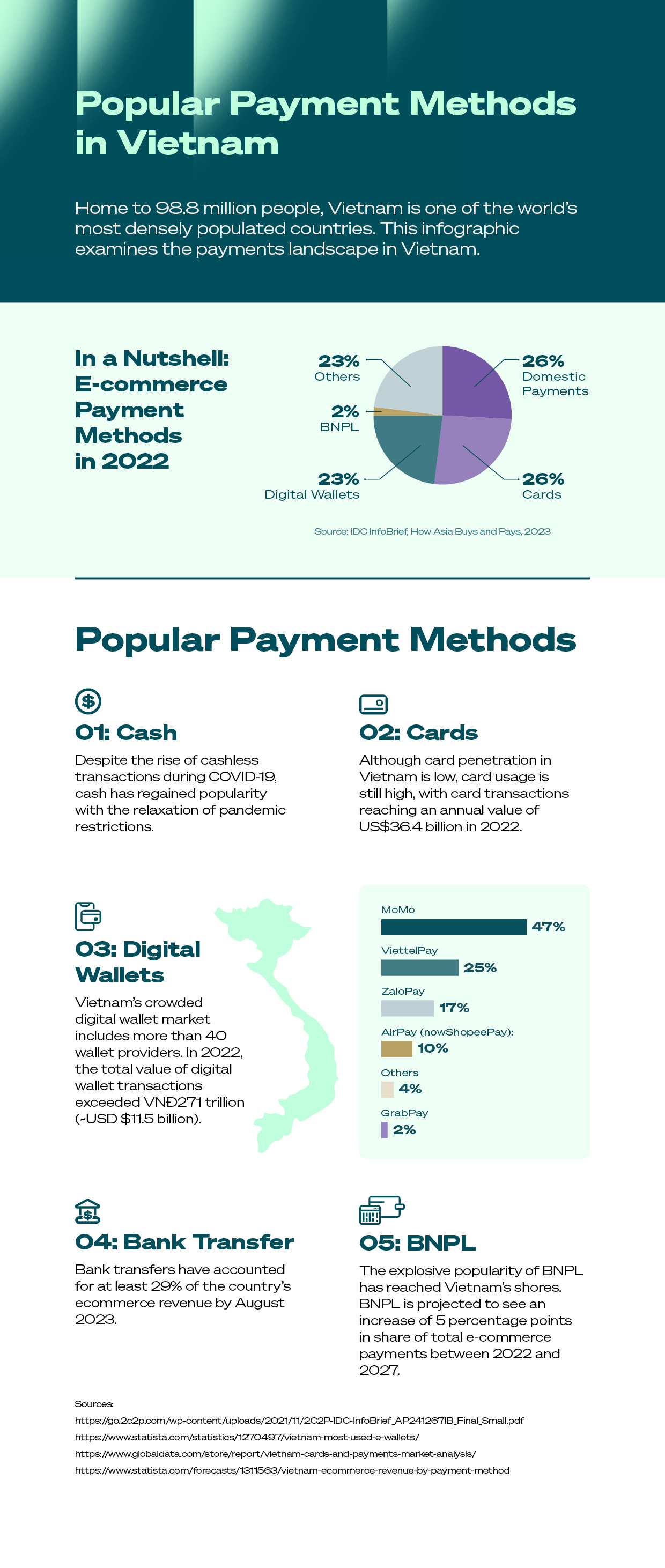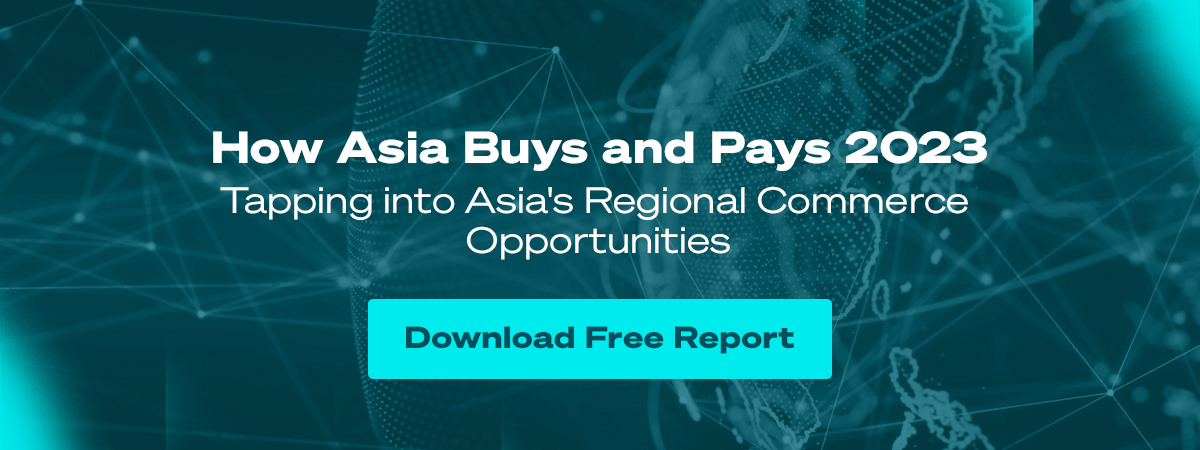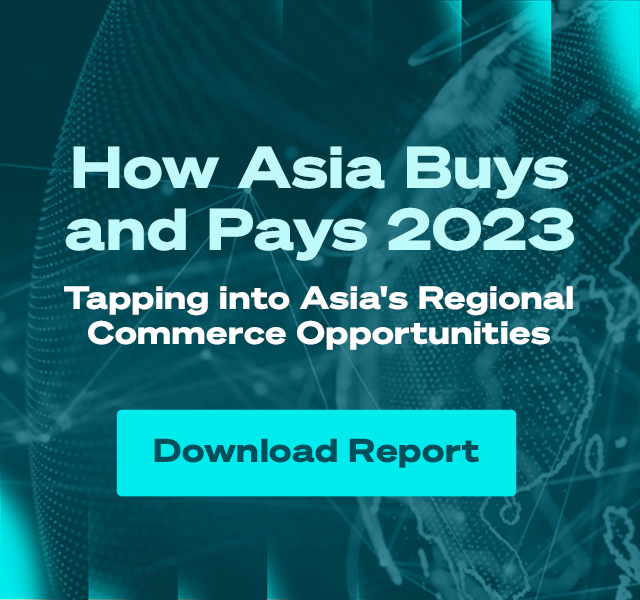
Popular Payment Methods in Vietnam: What Consumers Want
Home to 98.8 million people, Vietnam is the sixth largest economy in Southeast Asia, with a GDP of slightly over $400 billion. Similar to other Southeast Asia countries such as Indonesia, the Philippines, and Thailand, Vietnam is traditionally cash-heavy.
As was the case with many other markets around the world, Vietnam experienced a surge in digital payment adoption during the COVID-19 pandemic. In 2021, the transaction value of digital commerce in Vietnam reached US$12.3 billion. This figure is projected to reach US$19.5 million by 2025.
Although cash is still a significant payment method in Vietnam, the outlook for digital payments remains promising. This is because Vietnam boasts a mobile-first population that is highly receptive to digital and technological advancements. According to GSMA Intelligence, the number of mobile connections in Vietnam was equivalent to 164% of the total population in January 2023, a 4.7 million increase from 2022.
In this article, we will explore the most popular payment methods in Vietnam, summarised as follows:
- Cash, but digital has gained momentum
- Cards
- Digital wallets
- Bank transfers
- Buy Now, Pay Later (BNPL)

Cash, but digital has gained momentum
Cash is king in Vietnam
While cashless transactions in Vietnam rose by 169% between 2020 and 2021 due to COVID-19, cash has recently been experiencing a massive comeback as pandemic restrictions have eased.
In 2020, a colossal 90% of Vietnamese citizens preferred cash-on-delivery over all other payment options - the highest in the region.
In 2021, the FIS Global Payments Report found that 58% of Vietnam’s point-of-sale (POS) transactions were made in cash. By the end of April 2021, 11.53% of all payments in Vietnam were made in cash.
This preference for cash endures despite the rising popularity of cashless digital payments in the region. According to Vietnam Economy News, payment security is a key reason, with people perceiving cash as more secure than digital payments.
Cash usage is especially prolific in rural, remote, and isolated areas, where the populations tend to be underbanked. Cash is also preferred even on ecommerce platforms, where few merchants accept digital payments.
Despite the popularity of cash in Vietnam, though, the fact remains that the local population is predominantly young and tech-savvy, making them more inclined to embrace digital payment options. As of 2022, 73.5% of the adult population owns smartphones - that’s at least 63.1 million smartphones actively used in Vietnam.
National Digital Transformation Programme
The Vietnamese government has taken measured steps to accelerate the country’s digital transformation, implementing the National Digital Transformation Programme by 2025, with an orientation towards 2030.
Through this programme, the Vietnamese government aims to boost the country’s digital transformation by making key changes to awareness, enterprise strategies, and incentives.
Businesses, cooperatives, and business households fall under the purview of this programme, which will give them a leg up to boost their production, business efficiency, and overall competitiveness.
Below are some payment-oriented goals that the National Digital Transformation Programme seeks to achieve:
- 50% of banking operations by customers to be fully online
- 50% of the Vietnamese population to have a digital checking account
- 70% of customer transactions to be made via digital channels
- 70% of work and service records at credit institutions to be processed and stored digitally
The city of Ha Long on Vietnam’s northern coast set a target of 20-25% average annual growth in the number and value of cashless payments by 2025. This is part of its plan to boost digital payment transactions by making the use of digital payment methods a habit of urban residents.
Given how active the local authorities are in developing and executing initiatives to encourage digital payment usage, Vietnam’s digital transformation is inevitable. Visa’s latest Consumer Payment Attitudes study reflects this: almost 76% of consumers surveyed use mobile wallets, and 82% use cards.
Cards
Cards process a significant amount of purchases, with the annual value of card transactions in Vietnam valued at US$36.4 billion in 2022. This is despite Vietnam’s low card penetration rates, with debit card ownership standing at 1.29 per capita and credit card ownership at 0.08 per capita.
COVID-19 had a massive hand in promoting card usage in Vietnam, with consumers turning to cashless options like cards to pay for their online purchases. GlobalData's Payment Card Analytics revealed that the value of card payments in Vietnam registered a growth of 13.7% in 2021, a sharp increase compared to a growth of 2.2% in 2020.
The government and central bank have also worked in tandem to promote the adoption and usage of payment cards. This encompasses mandating the issuance of chip and PIN cards, enabling online account opening, raising awareness of digital payments, and improving overall payment acceptance infrastructure.
As of October 2023, there were over 113.07 million domestic cards and 32.81 million international cards in Vietnam, according to the State Bank of Vietnam (SBV).
Digital wallets
As is the case with its Southeast Asian neighbours, Vietnam has experienced a massive uptake of digital wallets. According to Statista, the penetration rate of mobile wallets in Vietnam is projected to grow from 19.7% in 2020 to 55.5% in 2025.
In June 2022, the total value of digital wallet transactions reached more than VNĐ271 trillion (~US$11.5 billion). More than 39 million digital wallets were activated in Vietnam, representing an increase of 3.68% compared to end-2021.
Competition is fierce in Vietnam’s digital wallet market. The country now has a crowded field of more than 40 digital wallet providers, seven times more compared to 2015. This means that providers must constantly devise new offers and features to expand and retain their customer base.
Below are the top digital wallets used in Vietnam:
- MoMo: 47%
- Viettel Pay: 25%
- ZaloPay: 17%
- AirPay (now ShopeePay): 10%
- Others: 4%
- Grab (with Moca Wallet): 2%
Looking ahead, Vietnam’s digital wallet market will only continue to grow. According to an IDC infobrief commissioned by 2C2P, the number of Vietnam’s digital wallet users is projected to grow from 18.3 million in 2020 to 61.6 million in 2025.
Bank transfers
Bank transfers are a key payment method in Vietnam, accounting for at least 29% of the country’s ecommerce revenue by August 2023. This figure is expected to remain stable in the next few years until 2025, reaching a peak of about 30%.
In Vietnam, bank transfers are primarily done through NAPAS. Short for the National Payment Corporation of Vietnam, NAPAS is credited with the development of the national retail payment infrastructure.
Convenience and ease of use are significant reasons behind the popularity of bank transfers. Under the NAPAS framework, the Vietnamese have access to the following products and services:
- Domestic switching service
- International switching service
- Electronic clearing and payment service
- Electronic good faith collection/payment service
- Payment gateway service
- 24/7 funds transfer service
Through NAPAS, Vietnamese residents can perform bank transfers with their smartphones. Given the proliferation of smartphones in Vietnam, it is no surprise that mobile banking is widely used. According to the State Bank of Vietnam, the transaction volume of domestic payments made via mobile banking in Q1 2023 was approximately 1.5 billion.
NAPAS also launched VietQR in 2021, adding QR code payment functionality to its real-time bank transfer system. Over the first half of 2023, QR code payments in Vietnam increased by 152% in quantity and 301% in value – recording the highest surge amongst non-cash payment types. At present, over 50 banks are connected under this standardised QR code system.
As new technological innovations are introduced, bank transfers will continue to be a preferred payment method in Vietnam. For starters, the global financial settlement network EMQ expanded its real-time international payment capabilities across Vietnam in 2020, enabling cross-border transfers to and from Vietnam in real time.
In 2023, Vietnam’s Central Bank signed a cross-border payments agreement to join Indonesia, Malaysia, Thailand, the Philippines and Singapore in working to connect each of their payment systems, including using the QR (quick response) code system for retail transactions.
Buy Now, Pay Later (BNPL)
The explosive popularity of BNPL has reached Vietnam’s shores. According to the IDC report commissioned by 2C2P, BNPL spending on e-commerce in Vietnam is projected to increase by 5 percentage points in market share between 2022 and 2027.
BNPL is especially appealing to the younger millennial and Gen Z populations, who are usually unlikely to own credit cards. BNPL is thus most beneficial to them, giving them the flexibility of interest-free instalment payments without needing a credit card.
Key BNPL players operating in Vietnam include Atome, AfterPay, Fundiin, Grab, Litnow, and Kredivo.
Vietnam will become digital-first in payments
Cash may remain popular in Vietnam, but digital payments are gaining significant traction. With the government and central bank working tirelessly to digitally transform Vietnam through their joint Digital Transformation Plan, we can expect digital payments to be more widely embraced by the Vietnamese. In fact, the DBS Financial Services Group’s 2023 survey on digital transformation ranked Vietnam second behind Singapore in terms of their approach to digitalising customer experience and engagement.
Furthermore, cashless payments are especially popular amongst Vietnam’s youth. According to a 2022 study by Visa on consumer payment attitudes in Southeast Asia, 77% of Vietnamese consumers have attempted to go fully cashless, and 64% believe they can go cashless successfully for a week or longer. Vietnamese youth have proven to be quick to adapt to new technological advancements, and with digital infrastructure such as 5G mobile coverage also set to improve, cashless payments are on track to be more widely used across this demographic.
Given the burgeoning population of Vietnam's youth, as well as the country’s sustained push for technological transformation, Vietnam’s digital-first future is all but secured.
Read more on Popular Payment Methods
Learn more about the top payment methods around the world. Check out the other articles in our Popular Payment Methods series:
About 2C2P
2C2P is a full-suite payments platform helping businesses securely accept payments across online, mobile and offline channels, as well as providing issuing, payout, remittance and digital goods services.
With over 400 payment options ranging from credit cards to mobile wallets and an alternative payments network of more than 600,000 physical locations, 2C2P is the preferred payments platform of tech giants, airlines, online marketplaces, retailers and other global enterprises.
Want to take your business further in Vietnam? Our friendly team is ready to help - talk to us today.

